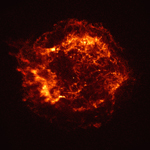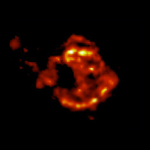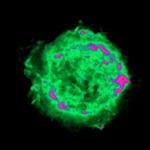CXC Home | Search | Help | Image Use Policy | Latest Images | Privacy | Accessibility | Glossary | Q&A
What Do These Images Tell Us?
X-ray

These images show Cas A as
viewed by four different types of telescopes. The X-ray image of the
Cassiopeia A supernova remnant on the left is the official first light
image of the Chandra X-ray Observatory. The 5,000 second image was
made with the Advanced CCD Imaging Spectrometer (ACIS). Two
shock waves are visible: a fast outer shock and a slower inner shock.
The inner shock wave is believed to be due to the collision of the
ejecta from the supernova explosion with a circumstellar shell of
material, heating it to a temperature of ten million degrees. The
outer shock wave is analogous to an awesome sonic boom resulting from
this collision. The bright object near the center may be the long
sought neutron star or black hole that remained after the explosion
that produced Cas A.
Optical

The optical image of Cas A
shows matter with a temperature of about ten thousand degrees. Some
of these wisps contain high concentrations of heavy elements and are
thought to be dense clumps of ejected stellar material.
Infrared

The infrared image of Cas A
shows dust grains that have been swept up and heated to several hundred
degrees by the expanding hot gas. It is not known whether the dust
grains were ejected by the star millions of years before it exploded
or during the explosion.
Radio

Cas A gets its name from radio
astronomers, who ‘rediscovered' it in 1948 as the strongest
radio source in the constellation of Cassiopeia. About 5 years later
optical astronomers found the faint wisps, and it was determined that
Cas A is the remnant of an explosion that occurred about 300 years
ago. The radio emission comes from high-energy electrons moving in
large spirals around magnetic field lines of force.
Return to Cassiopeia A (26 Aug 99)


